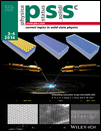Luminance and current distribution of hybrid circular GaN-based resonant-cavity light-emitting diodes with lateral current injection on the n- and p-side
Abstract
Resonant-cavity light-emitting diodes emitting at around 400 nm based on an undoped bottom AlInN/GaN distributed Bragg reflector (DBR) and a top dielectric SiO2/ZrO2 DBR with circular emitting apertures of diameters ranging from 5 to 200 µm are demonstrated. The current distribution is investigated by luminance distribution imaging and three-dimensional device simulations for different current densities. The current distribution exhibits a maximum in the aperture centre or is homogeneous up to an aperture diameter of 50 µm independent of the current density. A minimum occurs in the aperture centre for larger diameters increasing with increasing diameter and current density. The current distribution improves with larger n-GaN thickness and higher contact resistance between the transparent In2O3:Sn (ITO) electrode and the p-GaN contact layer. (© 2014 WILEY-VCH Verlag GmbH & Co. KGaA, Weinheim)




